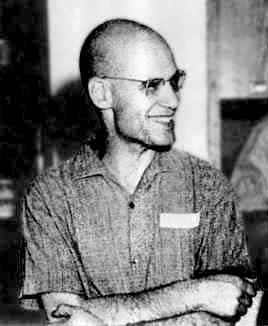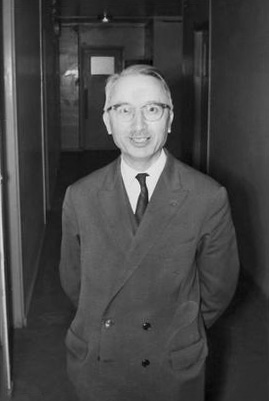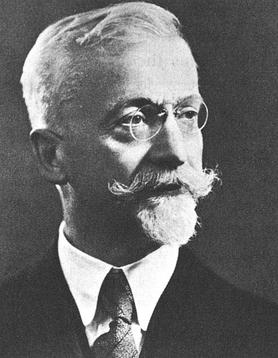
André Weil was a French mathematician, known for his foundational work in number theory and algebraic geometry. He was one of the most influential mathematicians of the twentieth century. His influence is due both to his original contributions to a remarkably broad spectrum of mathematical theories, and to the mark he left on mathematical practice and style, through some of his own works as well as through the Bourbaki group, of which he was one of the principal founders.

Alexander Grothendieck was a stateless mathematician who became the leading figure in the creation of modern algebraic geometry. His research extended the scope of the field and added elements of commutative algebra, homological algebra, sheaf theory, and category theory to its foundations, while his so-called "relative" perspective led to revolutionary advances in many areas of pure mathematics. He is considered by many to be the greatest mathematician of the twentieth century.

Nicolas Bourbaki is the collective pseudonym of a group of mathematicians, predominantly French alumni of the École normale supérieure (ENS). Founded in 1934–1935, the Bourbaki group originally intended to prepare a new textbook in analysis. Over time the project became much more ambitious, growing into a large series of textbooks published under the Bourbaki name, meant to treat modern pure mathematics. The series is known collectively as the Éléments de mathématique, the group's central work. Topics treated in the series include set theory, abstract algebra, topology, analysis, Lie groups and Lie algebras.

Jean-Pierre Serre is a French mathematician who has made contributions to algebraic topology, algebraic geometry and algebraic number theory. He was awarded the Fields Medal in 1954, the Wolf Prize in 2000 and the inaugural Abel Prize in 2003.
In geometry, the notion of a connection makes precise the idea of transporting local geometric objects, such as tangent vectors or tensors in the tangent space, along a curve or family of curves in a parallel and consistent manner. There are various kinds of connections in modern geometry, depending on what sort of data one wants to transport. For instance, an affine connection, the most elementary type of connection, gives a means for parallel transport of tangent vectors on a manifold from one point to another along a curve. An affine connection is typically given in the form of a covariant derivative, which gives a means for taking directional derivatives of vector fields, measuring the deviation of a vector field from being parallel in a given direction.

Henri Paul Cartan was a French mathematician who made substantial contributions to algebraic topology.

Claude Chevalley was a French mathematician who made important contributions to number theory, algebraic geometry, class field theory, finite group theory and the theory of algebraic groups. He was a founding member of the Bourbaki group.

Élie Joseph Cartan was an influential French mathematician who did fundamental work in the theory of Lie groups, differential systems, and differential geometry. He also made significant contributions to general relativity and indirectly to quantum mechanics. He is widely regarded as one of the greatest mathematicians of the twentieth century.

Charles Ehresmann was a German-born French mathematician who worked in differential topology and category theory.

Jean Alexandre Eugène Dieudonné was a French mathematician, notable for research in abstract algebra, algebraic geometry, and functional analysis, for close involvement with the Nicolas Bourbaki pseudonymous group and the Éléments de géométrie algébrique project of Alexander Grothendieck, and as a historian of mathematics, particularly in the fields of functional analysis and algebraic topology. His work on the classical groups, and on formal groups, introducing what now are called Dieudonné modules, had a major effect on those fields.

The Société Mathématique de France (SMF) is the main professional society of French mathematicians.
In mathematics, in particular in homological algebra, a differential graded algebra is a graded associative algebra with an added chain complex structure that respects the algebra structure.
The Séminaire Nicolas Bourbaki is a series of seminars that has been held in Paris since 1948. It is one of the major institutions of contemporary mathematics, and a barometer of mathematical achievement, fashion, and reputation. It is named after Nicolas Bourbaki, a group of French and other mathematicians of variable membership.
Continuation of the Séminaire Nicolas Bourbaki programme, for the 1950s.
Fondements de la Géometrie Algébrique (FGA) is a book that collected together seminar notes of Alexander Grothendieck. It is an important source for his pioneering work on scheme theory, which laid foundations for algebraic geometry in its modern technical developments. The title is a translation of the title of André Weil's book Foundations of Algebraic Geometry. It contained material on descent theory, and existence theorems including that for the Hilbert scheme. The Technique de descente et théorèmes d'existence en géometrie algébrique is one series of seminars within FGA.
"Esquisse d'un Programme" is a famous proposal for long-term mathematical research made by the German-born, French mathematician Alexander Grothendieck in 1984. He pursued the sequence of logically linked ideas in his important project proposal from 1984 until 1988, but his proposed research continues to date to be of major interest in several branches of advanced mathematics. Grothendieck's vision provides inspiration today for several developments in mathematics such as the extension and generalization of Galois theory, which is currently being extended based on his original proposal.
André Haefliger was a Swiss mathematician who worked primarily on topology.

Luc Illusie is a French mathematician, specializing in algebraic geometry. His most important work concerns the theory of the cotangent complex and deformations, crystalline cohomology and the De Rham–Witt complex, and logarithmic geometry. In 2012, he was awarded the Émile Picard Medal of the French Academy of Sciences.
Robert C. Hermann was an American mathematician and mathematical physicist. In the 1960s Hermann worked on elementary particle physics and quantum field theory, and published books which revealed the interconnections between vector bundles on Riemannian manifolds and gauge theory in physics, before these interconnections became "common knowledge" among physicists in the 1970s.










